Killifish, specifically the Aphyosemion striatum, are fascinating freshwater fish known for their vibrant colours and unique behaviours.
These little beauties can be found in various freshwater habitats around the world, from temporary ponds in Africa to slow-moving streams in South America.
Their adaptability is truly remarkable.
While many killifish species share basic care needs, their diversity means that some, especially the annual and non-annual types, have specific requirements based on their natural habitats.
For instance, some species can survive in temporary water bodies (mostly ponds) by laying eggs that can withstand long periods of drought, only hatching when the conditions are just right.
In this Killifish Overview Guide, we’ll walk you through everything you need to know to care for these captivating fish, ensuring they thrive in your aquarium.
Let’s dive in!
Table of Contents
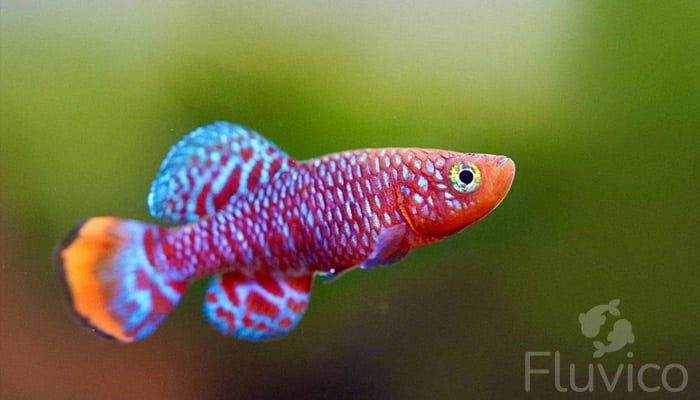
Killifish Facts & Overview
| Killifish Fact: | Details |
| Scientific Name: | Aphyosemion striatum but can vary buy species |
| Common Names: | Killifish, Bluefin Notho, Striped Panchax, and many more |
| Care Level: | Moderate (may vary with species) |
| Native Region: | Freshwaters worldwide, notably Africa and South America |
| Lifespan: | 3 months to 5 years, depending on species |
| Size: | Typically 2-3.5 inches (5-9 cm, varies by species) |
| Family: | Cyprinodontidae |
| Diet: | Primarily insectivores but also Carnivore |
| Minimum Tank Size: | At least 10 gallons (38 litres) for most species |
| Compatibility: | Generally peaceful; best with fish of similar size |
Species Summary
Killifish are part of the Cyprinodontiformes order, which includes over 1,000 species found all over the world. These small fish, usually between 2 to 3.5 inches long, are known for their bright colors and unique patterns.
They come from a variety of habitats, ranging from African deserts to South American rainforests, and have adapted in fascinating ways to their environments.
Some species lay eggs that can survive droughts in temporary water bodies, ensuring they can live through different seasons.
While many killifish can thrive in similar aquatic conditions, their wide diversity means that each type may need specific care.
Killifish Lifespan
The lifespan of killifish varies depending on the species and their environment. Generally, they live between 1 to 5 years.
Annual killifish species have shorter lifespans, often just a year, due to their adaptation to seasonal water bodies.
Non-annual species usually live longer. With proper care and the right tank conditions, you can significantly extend their lifespan.
Appearance & Size
Killifish are visually stunning, with a wide range of colours and patterns that make them a beautiful addition to any aquarium.
Their colours can vary from iridescent blues to fiery reds, reflecting their diverse origins. In terms of size, they are typically small, with most species measuring between 2 to 3.5 inches in length.
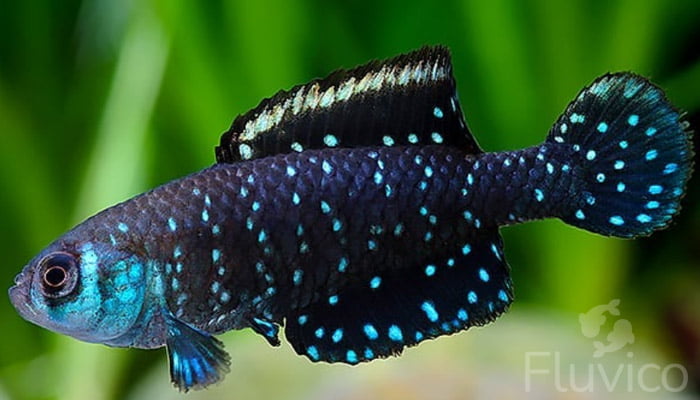
Different Types of Killifish
Killifish are a diverse group of fish that come in a variety of species, each with its own unique attributes and behaviors. They are broadly categorized into two main types: annual and non-annual killifish. Understanding these categories and their specific care requirements is crucial for any fish keeper.
Annual Killifish
Annual killifish are fascinating creatures that originate from seasonal water bodies like temporary ponds and streams.
These fish have an incredible adaptation: they produce eggs that can survive long periods of drought. The eggs lie dormant in the dry mud and hatch only when the rains return.
Due to their short-lived habitats, annual killifish typically have a lifespan of just one year. Knowing their unique life cycle is essential for providing the best care.
Top 5 Common Annual Killifish:
- Nothobranchius rachovii (Blue Notho)
- Origin: Africa
- Max Length: 2.5 inches
- Lifespan: 1 year
- Description: Bright metallic red with blue speckles and showy fins.
- Nothobranchius guentheri (Redtail Notho)
- Origin: Africa
- Max Length: 2.5 inches
- Lifespan: 1 year
- Description: Bright red with metallic blue stripes and a striking lyretail.
- Austrolebias bellottii
- Origin: South America
- Max Length: 2 inches
- Lifespan: 1 year
- Description: Known for its vibrant colors and adaptability to temporary water bodies.
- Austrolebias nigripinnis (Blackfin Pearl Killifish)
- Origin: South America
- Max Length: 2 inches
- Lifespan: 1 year
- Description: Features a striking black fin and iridescent body.
- Simpsonichthys magnificus (Magnificent Killifish)
- Origin: South America
- Max Length: 1 inch
- Lifespan: 1 year
- Description: Pale blue or pink with vertical stripes and iridescent speckling.
Non-annual Killifish
Non-annual killifish, on the other hand, come from more stable aquatic environments that do not experience extreme seasonal changes.
These fish have longer lifespans, often exceeding a year, and their eggs hatch in more predictable patterns. When kept in aquariums, they require consistent water conditions that mimic their natural habitats.
Recognizing the differences between annual and non-annual species is key to nurturing these diverse creatures effectively.
Top 5 Common Non-annual Killifish:
- Aphyosemion striatum (Red-striped Killifish)
- Origin: Africa
- Max Length: 2 inches
- Lifespan: 3-5 years
- Description: Red stripes and speckles from nose to tail, similar to fancy guppies.
- Aphyosemion australe (Golden Lyretail)
- Origin: Western Africa
- Max Length: 2.5 inches
- Lifespan: 3 years
- Description: Orange body with a showy anal fin and lyretail bordered with bright orange stripes.
- Fundulopanchax gardneri (Steel Blue Lyretail Killifish)
- Origin: Africa
- Max Length: 2.5 inches
- Lifespan: 3-4 years
- Description: Green, yellow, blue, and red with red spots covering the body.
- Epiplatys annulatus (Clown Killifish)
- Origin: Africa
- Max Length: 1.5 inches
- Lifespan: 3-4 years
- Description: Alternating black and yellow stripes with a red and blue tail fin.
- Fundulopanchax sjostedti (Blue Gularis)
- Origin: West Africa
- Max Length: 5.5 inches
- Lifespan: 3-4 years
- Description: Electric blue body with deep red spots and stripes, and an ornate tail.
By understanding the unique needs and characteristics of both annual and non-annual killifish, you can create an optimal environment for these stunning fish to thrive in your aquarium.

Behaviour/Compatibility for Killifish
Typically placid, but they can be territorial, especially during breeding periods. They are often found dwelling in the middle to top regions of the tank, showcasing their vibrant colours. While they can coexist with many species, it’s essential to pair them with tank mates that won’t outcompete or bully them.
What Are Good Tank Mates?
- Tetras: Small, peaceful, and found in similar water conditions.
- Rasboras: Another petite species that prefers the top layers of water.
- Corydoras Catfish: Bottom dwellers, they won’t intrude on the killifish’s territory.
- Shrimps: Like cherry or amano shrimps, they’re non-aggressive and add diversity to the tank.
- Dwarf Gouramis: Peaceful by nature, they coexist well with killifish.
- Snails: Great for tank cleaning and won’t disturb the fish.
Unsuitable Tank Mates
- Large Cichlids: Their territorial and sometimes aggressive nature can pose a threat.
- Oscars: Known to be predatory towards smaller fish.
- Arowanas: Predators by nature, they’ll likely see small killifish as food.
- Bettas: Especially male bettas, can be aggressive and territorial.
- Barbs: Some, like the Tiger Barb, are known fin-nippers.
- Plecos: Larger species can be aggressive and may disturb killifish.
- Aggressive Catfish species: Like the Pictus Catfish, they might chase or nip at killifish.

Aquarium Requirements
Ensuring optimal conditions for killifish within an aquarium is paramount for their health and well-being. With their diverse origins and unique needs, it’s imperative for aquarists to provide an environment that closely mirrors their natural habitat.
Minimum Tank Size
Though small, these fish require adequate space for swimming and exhibiting natural behaviours. A minimum of 10 gallons is recommended for a small group. However, if planning on breeding or housing multiple species, a larger tank may be necessary.
Other Tank Considerations
- Substrate: Opt for fine-grained sand or soft substrate to mirror their natural habitats and protect their delicate fins.
- Plants: Live aquatic plants provide shelter, spawning grounds, and make the environment more naturalistic.
- Filtration: A gentle, adjustable filter ensures clean water without creating strong currents that could stress the fish.
- Lighting: Moderate lighting that simulates their natural environment is preferred.
Natural Habitat
Killifish are found in a variety of freshwater habitats around the world, from shallow temporary ponds in Africa to slow-flowing streams in South America. These habitats are often densely planted with moderate to low light conditions. Understanding their origin aids in replicating a comfortable environment.
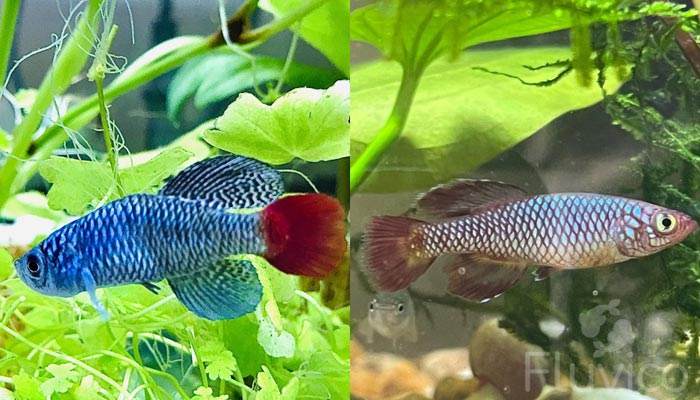
Water Requirements
- Temperature: Ranges between 20°C to 26°C, though specific needs can vary based on species.
- pH Level: Generally, a pH of 6.0 to 7.5 is suitable.
- Hardness: Soft to moderately hard water, with a dGH of 5-12, is preferred.
Regular water testing is essential to ensure these parameters are maintained and to keep the environment safe for the fish.
Housing Recommendations
- Decoration: Include driftwood and rocks to create hiding spots and territories.
- Safety: Ensure the tank has a tight-fitting lid as killifish are known jumpers.
- Tank Mates: Always consider the compatibility of other fish and ensure no overcrowding.
- Maintenance: Regular water changes and tank cleaning prevent the build-up of harmful toxins.
Compatible Plants for Killifish Aquariums
Plants enrich killifish tanks by offering shelter, improving water quality, and recreating natural habitats. Choosing compatible plants aids in achieving a harmonious environment that caters to the well-being of the fish.
Benefits of Aquatic Plants
- Oxygenate the water
- Absorb harmful nitrates
- Provide spawning grounds
- Offer refuge, mimicking wild habitats
Recommended Plants
- Water Lettuce: Floating plant with long roots, offering shade and refuge.
- Duckweed: Surface-covering plant that moderates light and absorbs nitrates.
- Dwarf Sagittaria: Carpeting plant, providing a natural substrate cover.
- Java Moss: Adaptable and provides fine shelter, ideal for fry.
- Hornwort: Fast-growing, aids in water purification.
- Anubias: Hardy and low-maintenance, provides structure in mid-ground.
- Java Fern: Thrives in varied conditions, offers dense foliage.
- Vallisneria: Grass-like appearance, suitable for background placement.
- Amazon Sword: Broad leaves, great for background and creating shade.
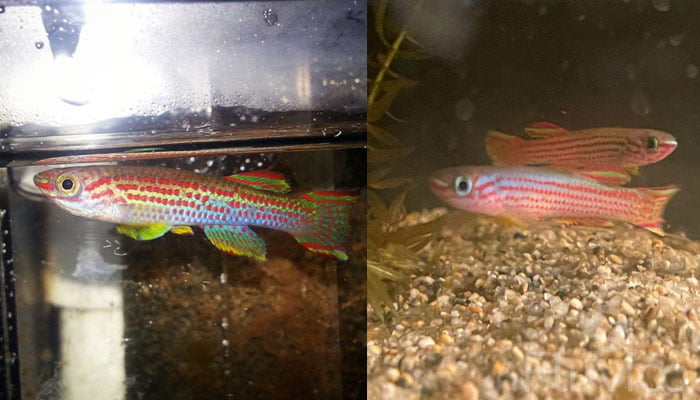
Diet and Nutrition
Providing a balanced diet is paramount to ensuring the health and vibrancy. These fish have specific dietary needs that, when met, contribute to their overall well-being, colour vibrancy, and breeding success. Understanding their natural diet and catering to it in an aquarium setting ensures longevity and overall vitality.
What Do Killifish Eat?
In the wild, killifish are primarily insectivores, feeding on a variety of small insects, larvae, and crustaceans. They often thrive on a diet rich in live or frozen foods, which emulate their natural feeding habits. Their agile, middle-to-surface dwelling nature makes them adept hunters, eagerly pursuing prey within their environment.
Ideal Food And Diet
Live Foods:
- Brine shrimp: Easily cultured, a favourite among many killifish species.
- Daphnia: A nutritious water flea providing essential fatty acids.
- Worms: Microworms or blackworms can be offered in moderation.
Frozen Foods:
- Bloodworms: High in protein, but should be fed sparingly.
- Mysis shrimp: A wholesome option providing both protein and essential fats.
Flake and Pellet Foods:
- High-quality, specially formulated diets can supplement live or frozen feedings.
Vegetation:
- Some species occasionally graze on soft algae or plant matter.
Feeding Recommendations
- Offer a varied diet to ensure all nutritional needs are met.
- Feed in small quantities, ideally 1-2 times daily, to prevent overfeeding.
- Observe during feeding to adjust amounts and identify preferences.
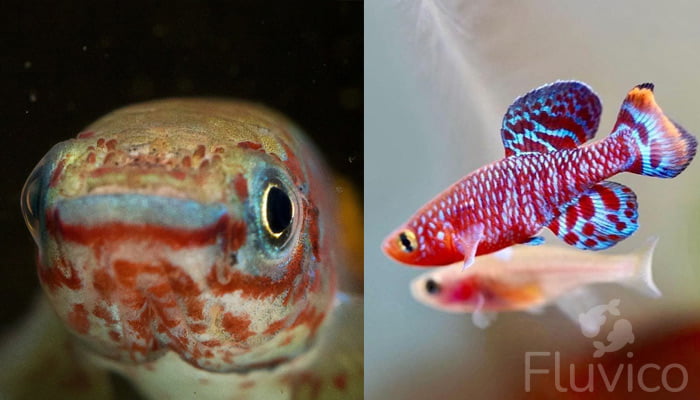
Breeding Killifish
Breeding killifish is a fascinating endeavour, allowing aquarists to observe the intricate lifecycle of these vibrant fish. Their breeding habits and requirements can differ greatly depending on the species. With the right knowledge and environment, successful breeding is attainable, paving the way for the next generation of these captivating creatures.
Breeding Level – Easy to Difficult
Killifish breeding difficulty varies considerably among species. Some are relatively easy to breed, requiring minimal intervention, while others may demand precise water parameters and specific breeding grounds. Being aware of the intricacies of each species is paramount for breeding success.
Annual Killifish
Annual killifish hail from temporary water bodies and have a unique reproductive strategy to match:
- Lifespan: Their natural lifespan is typically a year or less, aligning with the seasonal existence of their habitats.
- Egg Diapause: These killifish lay drought-resistant eggs that can endure dry periods. During this ‘diapause’, embryo development halts until favourable conditions return.
- Breeding in Captivity: To simulate their natural breeding cycle, a drying period followed by re-wetting is essential. Peat moss is often used as a substrate for egg laying, which can later be dried and stored.
Breeding Non-Annual Killifish
Non-annual killifish, found in permanent water bodies, have a more conventional breeding approach:
- Spawning Sites: They often prefer dense vegetation or spawning mops to lay their eggs.
- Egg Development: Unlike annuals, their eggs hatch in a shorter span, usually within 2-3 weeks.
- Breeding in Captivity: Providing ample hiding spots and a protein-rich diet can encourage spawning. Regular water changes and mimicking natural light cycles can further enhance breeding conditions.
Breeding Tips
- Research the specific breeding needs of the chosen species.
- Maintain pristine water quality and closely monitor water parameters.
- Separate breeding pairs or groups to create a dedicated breeding tank.
- Ensure a nutritious diet to condition fish for breeding.
Successful breeding not only provides a deeper appreciation for killifish but also contributes to the conservation of species, especially those that are rare or endangered in the wild.
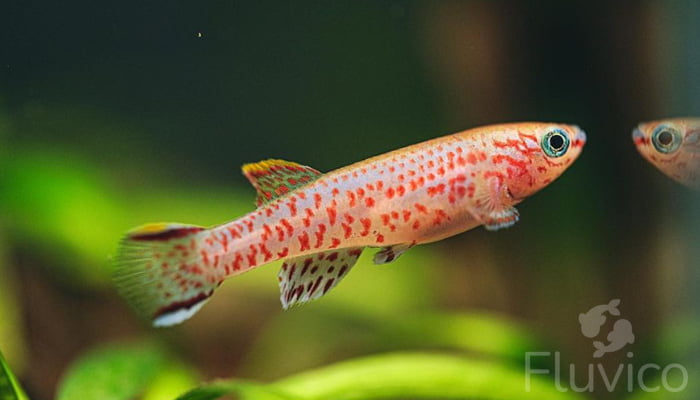
Additional Considerations
Keeping killifish is a rewarding experience, offering both aesthetic pleasure and the joy of observing their natural behaviours. However, it’s vital to weigh the pros, cons, and responsibilities. Knowing where to source these fish is equally crucial, ensuring healthy specimens and supporting responsible trade.
Should You Keep Killifish?
Killifish are undoubtedly captivating, but they’re not for everyone. Here are points to ponder:
Advantages:
- Diversity: They come in a plethora of colours and patterns, making them a visual treat.
- Behaviour: Observing their natural behaviours, especially during courtship and breeding, is fascinating.
- Community Tanks: Many species are peaceful and can thrive in community setups.
Challenges:
- Specific Needs: Some species require precise water parameters and diets.
- Short Lifespans: Particularly with annual species, their lifespans can be brief.
- Breeding: While rewarding, breeding certain species can be complex.
Considering these factors will help in making an informed decision about whether killifish are the right fit for your aquarium.
Where to Buy Killifish
Finding the right source is pivotal to ensuring you obtain healthy and ethically sourced killifish.
- Local Fish Stores: Reputed stores often stock a variety of killifish. Engaging with knowledgeable staff can provide insights into the fish’s origin and health.
- Killifish Associations: Many countries have dedicated associations, offering sales, swaps, and auctions.
- Online Retailers: Ensure they’re reputable and read reviews. Some specialise solely in killifish and provide detailed species information.
- Fish Shows & Conventions: These events often feature rare or unique species, giving you access to a broader range of options.
Purchase Tips
- Research the specific killifish species you’re interested in to identify their needs and compatibility.
- Quarantine new fish to ensure they’re disease-free before introducing them to your main tank.
- Support breeders and sellers who prioritise ethical and sustainable practices.
FAQ
Are Killifish aggressive?
Most are peaceful, but some can be territorial or aggressive, especially during breeding. Always research specific species for temperament and compatibility.
Do Killifish jump out of tanks?
Yes, they are known jumpers. It’s advisable to have a well-fitted lid on their tank to prevent them from leaping out and risking desiccation.
Will Killifish eat small fish?
Some larger species may prey on smaller fish, especially fry. It’s essential to choose tank mates of similar size and research species-specific tendencies to ensure compatibility.
Are Killifish related to Guppies?
No, killifish and guppies are not closely related. While both are freshwater fish, killifish belong to the family Cyprinodontidae, and guppies are part of the Poeciliidae family.
More Reading

15 Types of Cryptocoryne: Which is Best For Your Aquarium Setup?

16 Awesome Low Light Aquarium Plants (Mosses, Ferns & Stem Plants)


18 Types of Aquarium Moss: Photos, Care, Propagation & Growth Guide


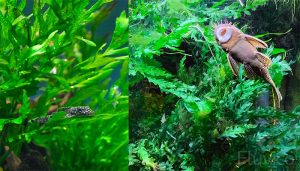




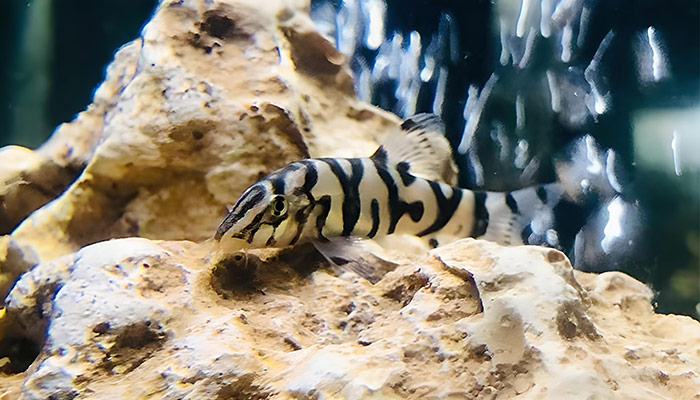
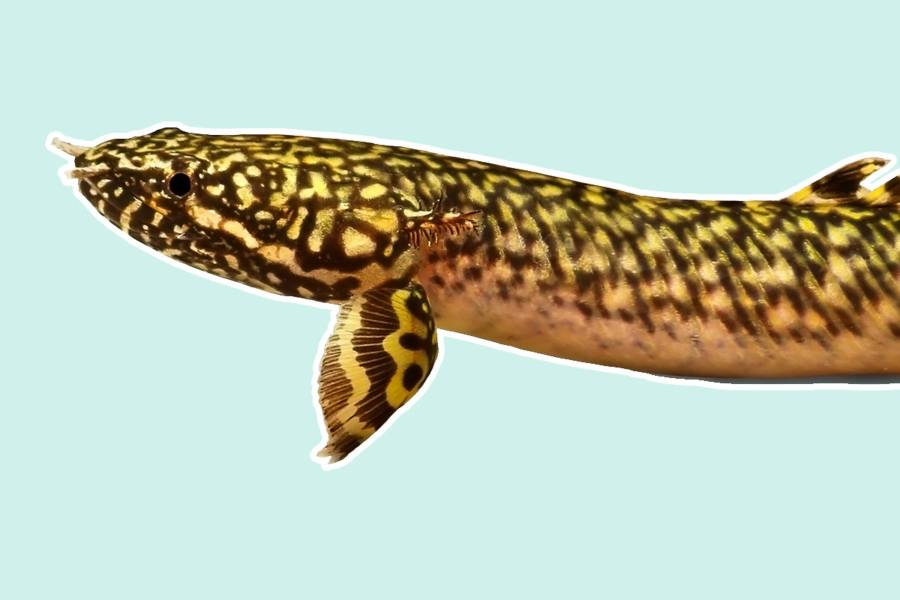
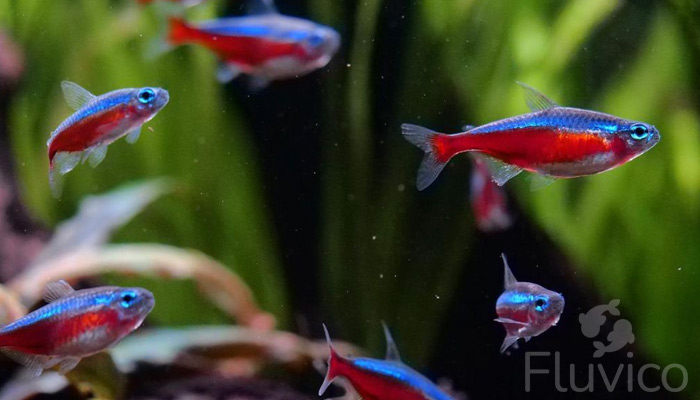

Hope you enjoyed our Killifish Care Guide!
If you have any questions? Ask away, we’re here to help!
All the best,
Daniel